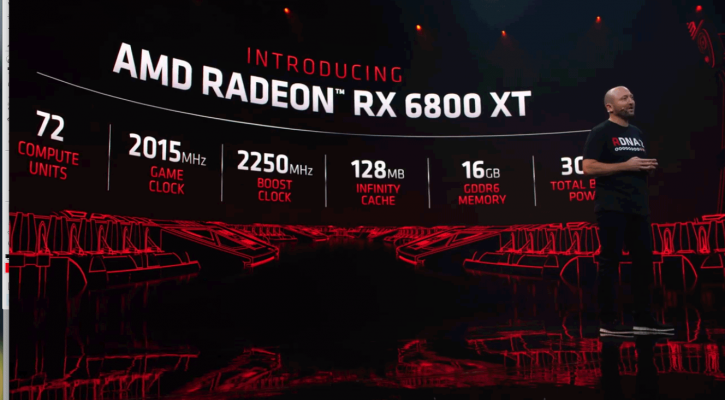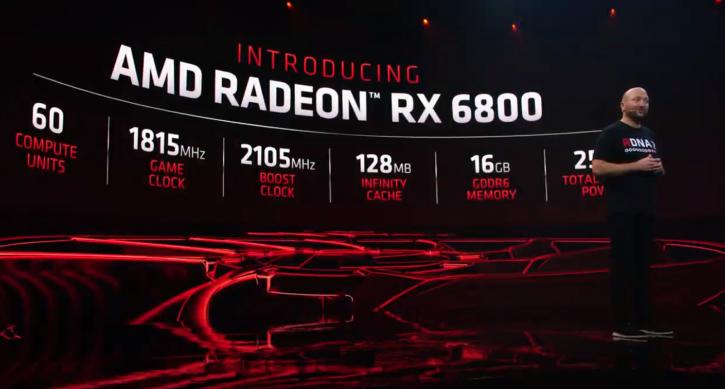AMD Radeon Series 6000
Radeon Series RX 6800, 6800 XT and 6900 XT
In this announcement preview overview a bit of analysis, we'll be discussing the pending Radeon Series 6800 and 6900 from AMD as well as a bit of RDNA2 architecture. This article is preliminary based on what AMD has been sharing (to date) and the stories that made the news in the past weeks. All that to get a grasp of what AMD is releasing with their new GPU architecture. We'll try and fill in the gaps in specifications as anything you read hereafter this point; some are unconfirmed.
It has been a long wait for AMD; when the original NAVI was launched, it became well respected. The 5600 and 5700 series does offer some good performance. But during that launch everybody was already talking about one thing, where is Big Navi? Here we are a year later, and the world completely changed. Next to everything COVID-19 related, in the world of graphics technology, a new dynamic was added, Raytracing. Or, I should say DirectX Raytracing (DX-R). NVIDIA was pioneering two years ago with their RTX 2000 series already, and AMD made the call to delay that for the original Navi GPU. As the graphics landscape changed somewhere done the line, so this the roadmap for AMD change. Microsoft and Sony consoles embedded with AMD technology revealed that Raytracing was going to be supported. And that did set the trend for the desktop graphics card we see announced today as well.
What to expect?
You may expect several graphics cards within the new 6000 lineups. Expect two Radeon RX 6800 (XT) graphics cards and a Radeon RX 6900 XT, and not just that last one is based on Big-Navi; they all are based on the same GPU. Inevitably, of course, there will be a Radeon RX 6700 series released as well. AMD claims a 50% perf per watt improvement in performance, double that of last-gen performance.
Flying clock speeds, 16GB GDDR6 for all
RDNA2 architecture on that same 7nm node seems susceptible to increase clock frequencies. RX 5700 XT sits around 1950MHz, the boost speed of the Radeon RX 6800 XT and 6900 XT should/could reach 2250 MHz. To appropriately serve the GPU with instructions and data, AMD increased the memory speed to 16Gbps on its Radeon RX 6000 GPUs. In addition, all cards have 16GB GDDR6, double that of the 5700 XT. The memory bus sits at 256-bit. To increase memory bandwidth AMD introduced 'Infinity Cache'.
Infinity Cache
One of the biggest changes from previous GPU architecture is Infinity Cache, a cache memory that will take the load off the memory bus and improve performance per watt. This memory is on the chip itself (on-die), and would be one of the reasons that the Navi 21 GPU is considerably larger than Navi 10. Normally a GPU has a few megabytes of cache memory (L1 and L2). Then there's a huge gap in between the many gigabytes of VRAM that the frame buffer has. This gap is bridged with Infinity Cache, basically, you could look at it as an L3 cache that is more capable to provide the GPU with sufficient and faster data in a faster manner, and reduces frame buffer utilization.
AMD mentions 128MB Infinity Cache used in combination with a 256-bit memory bus provides more than twice the bandwidth of a 384-bit memory bus. That L3 cache sits on the GPU die, ergo it's big size. That's a lot of transistors used for this feature. There's more to it all as the GPU now takes advantage of lower energy consumption because there is less utilization on the memory controllers. 128MB Infinity Cache is implemented and used on ALL the RX 6900 XT and 6800 XT and RX 6800 graphics cards.
Raytracing
AMD announced that it would introduce its Radeon RX 6000 series lineup on October 28, as we write this before the announcement, which is today. Before the announcements, a thing or two have leaked, but overall everybody is still guessing the new lineup's precise specifications. The rumor was that the flagship product would compete with NVIDIA's GeForce RTX 3080 and support DX-R, aka Raytracing, and DirectX ultimate in its entirety. We cannot say much about DXR performance but have calculated the number of RT cores inside the RDNA2 architecture as it is easy to math, 1 RT core per CU.
| Radeon RX 6000 vs GeForce RTX 30 | ||
|---|---|---|
| Graphics card | Ray Tracing Cores | Tensor Cores |
| Radeon RX 6900XT | 80 | - |
| Radeon RX 6800XT | 72 | - |
| Radeon RX 6800 | 60 | - |
| GeForce RTX 3090 | 82 | 328 |
| GeForce RTX 3080 | 68 | 272 |
| GeForce RTX 3070 | 46 | 184 |
Radeon RX 6800 XT
Big Navi has been announced with this 16GB card, and the chip will end up in three graphics cards. This Big Navi based chip has 26.8 Billion transistors. The 6800 XT will get 72 CUs multiplied by 64 shader units is 4608 shading processors. This card gets 16 GB of GDDR6 memory based on a 256-bit memory bus, not to confuse with new GDDR6X memory NVIDIA is using for RTX 3080 and 3090. So that means 512 GB/s of memory bandwidth and, in fact, would be equal to the bandwidth of the GeForce RTX 3070. The TDP listed is at 300 watts for this product. The 2250 GHz boost clock is spectacular. However, the more average game clock is listed at 2015 MHz. New is a 128 MB infinity cache, which we need to explain in our final review, of course. The card is to battle the GeForce RTX 3080 in performance. This graphics card will cost you a sweet sum of 649,- USD with an availability date of November 18th.
Radeon RX 6800 (Pro)
A derivative is the Radeon RX 6800 (Pro); this actually the same card as the 6800 XT, but let's call this somewhat castrated and probably the favorite card for many BIOS tweakers ;) It is more restrained with 60 CUs and thus 3840 Shading processors. It's 1815 MHz game clock and 2105 MHz Boost clock frequency is a notch lower as well. This card will battle with the GeForce RTX 2080 Ti and RTX 3070. The price is a notch better at 579 USD.
Radeon RX 6900 XT - The Mac Daddy
Three SKUs with a very similar design, all based on the same chip I stated, and that statement stands. This 16GB GDDR6 graphics card will get the full 80 CUs enabled. Multiply that with 64 shader units, and you'll count 5120 shading processors. This card gets 16 GB of GDDR6 memory based on a 256-bit memory bus. So that means 512 GB/s of memory bandwidth and, in fact, would be equal to the bandwidth of the RTX 3070. The TDP listed is 300 watts. This fully enabled Big Navi based chip has a whopping 26.8 billion transistors. The clocks are the same as the 6800 XT at a 2250 GHz boost and 2015 MHz game clock. According to AMD (below), this card will be able to battle with the GeForce RTX 3090. The card will become available on December 8th for 999 USD.
GPU Specifications
AMD announced three BiG Navi based graphics cards. Interesting was to learn the GPUs are fabricated on an optimized 7nm node derived from TSMC. The cards will be PCIe 4.0 interface compatible and offer HDMI 2.1 and DisplayPort 1.4a. Specs then, below an overview. The number of hardware-accelerated RT cores are TBA, but shader count, memory volume, and clock frequencies we can report.
| Desktop | ||||||||
| GPU | Stream Processors | RT Cores | Max Boost GPU clock (MHz) | RAM type | RAM volume (GB) | RAM bandwidth (GB/s) | RAM width | TDP (watts) |
| Radeon RX 6900 XT | 5120 | 80 | 2250 | GDDR6 | 16 | 512 | 256-bit | 300 |
| Radeon RX 6800 XT | 4608 | 72 | 2250 | GDDR6 | 16 | 512 | 256-bit | 300 |
| Radeon RX 6800 Pro | 3840 | 60 | 2105 | GDDR6 | 16 | 512 | 256-bit | 250 |
| Radeon RX 5700 XT | 2560 | 1605 | GDDR6 | 8 | 448 | 256-bit | 225 | |
| Radeon RX 5700 | 2304 | 1465 | GDDR6 | 8 | 448 | 256-bit | 180 | |
| Radeon VII | 3840 | 1400 | HBM2 | 16 | 1024 | 4096-bit | 300 | |
| Radeon RX Vega 64 | 4096 | 1247 | HBM2 | 8 | 484 | 2048-bit | 295 | |
| Radeon RX Vega 56 | 3584 | 1156 | HBM2 | 8 | 410 | 2048-bit | 210 | |
| Radeon RX 590 | 2304 | 1469 | GDDR5 | 8GB | 256 | 256-bit | 185 |
Pricing
The Radeon Radeon RX 6900 XT is to cost 999 USD, the RX 6800 XT costs 649 USD, and the Radeon RX 6800 will cost 579 USD
Availability
They are announced but then launched on 18th November and the 6900 XT on December 8th.
The Presentation
Below the announcements made by AMD.











